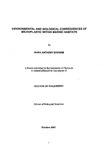ENVIRONMENTAL AND BIOLOGICAL CONSEQUENCES OF MICROPLASTIC WITHIN MARINE HABITATS
| dc.contributor.author | Browne, Mark Anthony | |
| dc.contributor.other | Faculty of Science and Engineering | en_US |
| dc.date.accessioned | 2013-02-11T12:04:15Z | |
| dc.date.available | 2013-02-11T12:04:15Z | |
| dc.date.issued | 2007 | |
| dc.identifier | Not available | en_US |
| dc.identifier.uri | http://hdl.handle.net/10026.1/1299 | |
| dc.description | Merged with duplicate record 10026.1/1932 on 06.20.2017 by CS (TIS) | |
| dc.description.abstract |
Large pieces of plastic greater than a millimetre in diameter contaminate marine habitats worldwide and the associated environmental problems are well documented. In addition tiny fragments of plastic debris less than a millimetre in size have recently been reported. This thesis examines the distribution and environmental consequences of microscopic particles of plastic within marine habitats. To quantify the relative influence of wind and depositional environment on the accumulation of plastic debris, a mensurative experiment was conducted in a macrotidal Estuary. The overall trend was that material accumulated in down-wind sites. However, the relative importance of wind as a transport agent depended on the size and density of the plastic. Natural sediments are transported according to their size; but the extent to which models of sediment dynamics could be applied to the transport of plastic debris remains untested. I examined relationships between the abundance of microplastic debris and sediment particle size, latitude and human population density using samples from sandy shores worldwide. Microplastic was found at every location, showing the global extent of this contamination and there was a significant positive correlation between human population density and microplastic abundance. Sewage sludge disposal grounds were examined as potential sources of microplastic. Replicate sediment grab samples showed that disposal grounds near Plymouth and Newcastle (UK) had greater abundance of microplastic debris compared to reference sites. To investigate the biological consequences of ingesting clean microplastic particles the mussel, Mytilus edulis (L.) was used as a model organism. The fate of ingested plastic was tracked within the body tissues using a laboratory trial. Mussels were exposed to 3.0 and 9.61µm microplastic particles in seawater for 3 hours and then transferred to clean conditions. After 3 days ingested microplastic had accumulated in the circulatory fluid of M edulis. Smaller particles 3.0 µm were present in the haemolymph in consistently higher numbers than larger particles, and both sizes were still present after 48 days. There were no measurable changes in organismal health from ingestion of this material. However, it has been frequently suggested that plastics debris may transfer chemical contaminants to marine life. To test this, the sorption-affinity of candidate environmental hydrophobic contaminants from aqueous solution onto microscopic particles of polyvinylchloride and similar sized particles of sand was compared. Chemical analysis confirmed that polyvinylchloride absorbed more contaminants than sand. A second experiment examined the bioavailability of sorbed contaminants and chemical additives that are incorporated into plastic during manufacture. Laboratory trials using Arenicola marina (L.) showed that the sorbed contaminants and additives bioconcentrated in gut tissues leading to deleterious biological effects. In conclusion, microplastic debris is a ubiquitous form of contamination and when ingested, this material can translocate from the gut to the circulatory system and haemocytes, and can transfer chemicals into animal tissues, and reduce the health of animals near the base of the food chain. The implications of these findings are discussed in relation to potential measures to improve the management of plastics in society and to reduce the amount of plastic entering the environment. | en_US |
| dc.language.iso | en | en_US |
| dc.publisher | University of Plymouth | en_US |
| dc.title | ENVIRONMENTAL AND BIOLOGICAL CONSEQUENCES OF MICROPLASTIC WITHIN MARINE HABITATS | en_US |
| dc.type | Thesis | |
| plymouth.version | Full version | en_US |
| dc.identifier.doi | http://dx.doi.org/10.24382/3851 |
Files in this item
This item appears in the following Collection(s)
-
01 Research Theses Main Collection
Research Theses Main


